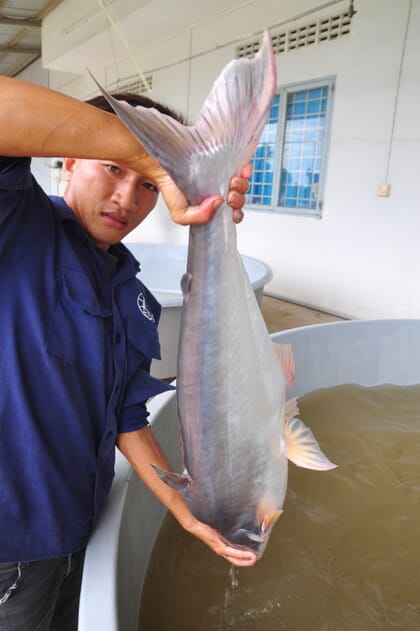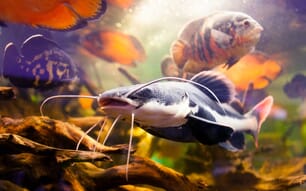In order to increase production and maximise profit, the farming of pangasius has been intensifying, but with this comes a risk of increased disease and problems caused by viruses, bacteria, fungi, parasites and other pathogens. One primary constraint to pangasius farming is disease, which generates high costs in areas such as prevention and treatment.
As long as culture conditions are good, pangasius are generally resistant to disease during the grow-out period but deteriorating water quality, handling or low water temperatures can all increase the likelihood of parasitic or bacterial infections.

Common disease problems include protozoan infestations on the skin or gills and bacterial infections from handling or environmental stress. As a fish with no scales, Pangasius is also highly susceptible to the protozoan parasite icthyopthirius multifilus.
Large-scale outbreaks and mortality in Pangasius are rare, but the following diseases have been recorded:
BNP (bacillary necrosis of pangasius)
This is caused by Edwardsiella ictaluri, a bacteria that survives in pond water for around two weeks and up to three to four months in pond mud. Fingerlings and juvenile fish are most at risk, although fish of all ages can be affected.
High stocking densities, pollutants, health problems and crowding can bring on the disease. It is usually fatal, and mortality rates increase rapidly.
Clinical signs tend to become apparent immediately before death when the fish swim slowly at the surface of the water, and look pale with internal white spots on the liver, kidney and spleen.
Red spot disease
Brought on by a group of motile aeromonas septicaemia, this disease occurs in fingerlings and during the grow-out phase.
Symptoms include slow swimming, no food intake, haemorrhages on the head, mouth and base of the fins and possible gas in the gut.
Conditions that favour red spot disease are high stocking densities, environmental pollutants and organic mud in ponds. Red Spot Disease is more likely to occur when the fish are stressed, for example during handling or transportation.
Parasite diseases
These are brought on by Trichodina spp and Epistylis spp. Symptoms include slow swimming at the surface of the water, disorientation, lesions, fin rot, white spots on the body and difficulty breathing.
Fish are also vulnerable to bacterial infections as they become very weak and have less of an appetite. Sporadic outbreaks with a low mortality rate also occur. Adverse climate conditions, such as downpours of rain followed immediately by sunshine, can help bring on the disease, as well as poor water quality and high stocking densities.
Prevention and treatment
Inadequate feed and a reduced oxygen level are among a range of stressors that can lead to potential pathogens invading pangasius and causing a disease outbreak.

Antibiotic agents are used widely for prevention and cure and to treat bacterial infections, but if water quality is too low or stocking density too high, the fish can once again become infected. If antibiotic agents are not applied properly, the fish could also be harmed by residue, which would then result in final products of poor quality.
Good aquaculture practices are key to limiting the spread of disease. Examples of such practices are to register farms so they can be monitored or controlled by local authorities, locate the farm in accordance with established local and national legal frameworks, incorporate wastewater treatment ponds and properly measure water parameters such as pH, oxygen and temperature to provide a sufficient water supply in quantity and quality, have a certificate of fingerling quality (important for disease traceability) and purchase high quality industrial feed.
It's critical to ensure that the fish are healthy prior to stocking and many farms may contact an expert in aquatic animal diseases who can check the fish prior to stocking and ensure that they are healthy.
The primary means of reducing the risk of disease outbreaks is to maintain a culture environment that exerts a minimum amount of stress. Farms must also frequently monitor fish behaviour and look out for signs such as loss of appetite or erratic swimming. Every effort should also be made to ensure that facilities are not exposed to pathogens from the outside.
In future, more research will be required to properly identify and characterize pathogens and develop further disease control measures and health management. Although various antibiotics and other medicine or chemicals are currently used to treat and prevent disease in Pangasius, the question now is how much farmers are aware of the proper techniques in prevention and treatment, and how willing they would be to invest in them.
Read more of The Fish Site's series on pangasius farming here.





